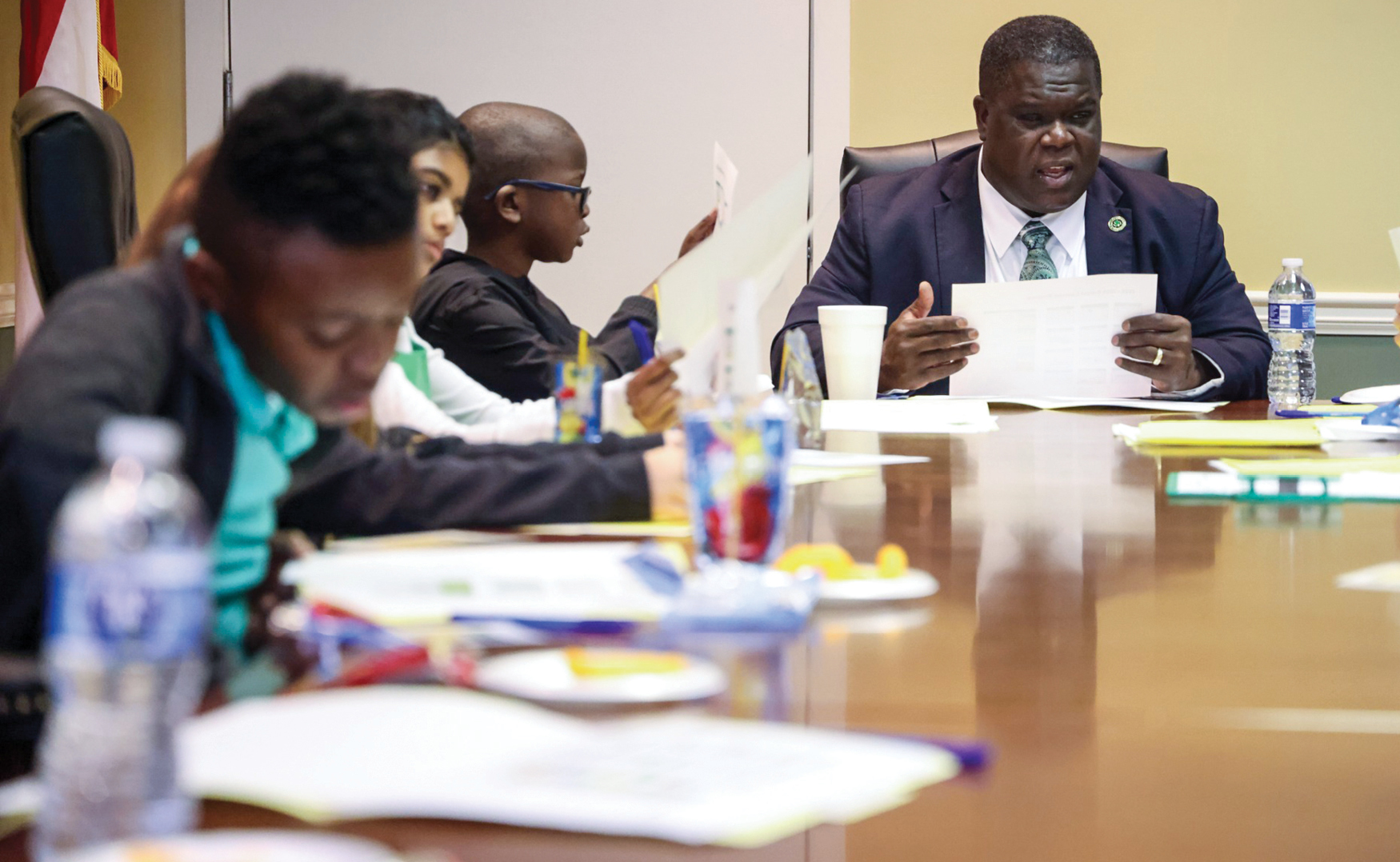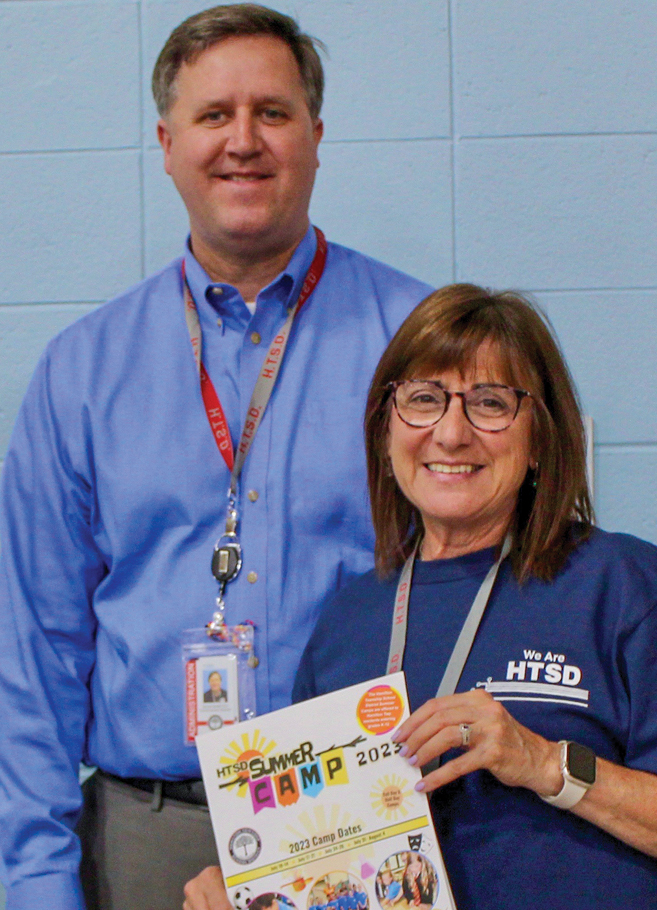A Whole Child Regimen to Reducing Absenteeism
October 01, 2024
A three-tiered approach in the Dublin city schools delivers the support for students to surmount obstacles

From the time I was in kindergarten, I knew I wanted to be a teacher and coach. As a third-generation educator, I grew up with my mom teaching students how to read from our front yard. I remember her explaining that for educators to be successful, they must love first and teach second.
Using her mantra and my own personal experiences pouring into the lives of Dublin City Schools students for the past 30 years, I know that for us to make a difference in their academic lives, we first have to support the needs of the whole child.
Research shows the pandemic significantly set back learning, particularly in high-poverty areas. As a Title I district with nearly 80 percent of families receiving government assistance, our children have been impacted more than most, especially as they wrestled with school closures, sickness, parent job losses and the complexities that kept them from attending school in an online environment.
During COVID-19, I learned of a gifted student who lived in poverty and wasn’t showing up to school in a virtual setting. So, masked up, a colleague and I drove to her home, knocked on her door and found the lights were off, the internet was disconnected, her mom had just been released from incarceration and didn’t have a job, and no food existed in the house. Talk about extenuating complexities that kept this child from attending school!
I’m proud to say our school district responded to meet each of those needs before the sun went down. We went beyond simply saying she’s not showing up for class by truly getting to the why behind the chronic absenteeism. Now that child, a 9th grader, is highly engaged in school and doing extremely well. She recently represented our school system as a Regional Educational Service Agency award winner.
Tiered Interventions
Shortly before the onset of COVID-19, about 9 percent of Dublin’s 2,300 students accrued more than 15 absences. During 2020-21, chronic absences increased to 35 percent of students, which continued upward to 43 percent in 2021-22.
Drastic measures had to be taken if we wanted to recoup the unfinished learning. Therefore, we convened a district attendance committee to develop a plan of action to address this crisis. The committee created a systemwide attendance protocol that moved us from a legalistic, punitive approach to a true problem-solving mode.
The Dublin City Schools uses a tiered approach to address student absences and ensure all students receive the support they need to maintain good attendance.
Tier 1: For all students, we have proactive measures in place when they miss a day of school. After teachers take daily attendance, families receive a phone call or home visit from a member of our school-based attendance team. The latter, which exists at all of our schools, consists of the school’s family engagement coordinator, school counselor, school social worker, administrative assistant and building administrators.
When a learner misses two or more days, the family not only hears from our school-based attendance team but also receives personalized contact from the teacher.
When a student amasses four unexcused absences, a parent meeting takes place to discuss external complexities and barriers that are preventing consistent attendance, barriers and complexities that the school might be presenting that impact the child’s attendance and a review of the district’s attendance policy.
Tier 2: For students who miss more than five days, we offer targeted support. In addition to all Tier 1 supports, this involves counselors setting up a school-level meeting with the child’s family to develop a personalized attendance improvement plan and determine what additional resources or interventions can be provided.
Tier 3: When a student accumulates more than eight unexcused absences, we implement intensive support strategies. In addition to supports provided in Tiers 1 and 2, this intervention requires more frequent meetings with parents, involving school counselors and/or social workers and collaborating with community agencies to address the factors contributing to chronic absenteeism.
Data-Driven Monitoring
In addition to school-based attendance teams making daily contact, the district also monitors trends by pulling daily attendance reports and contact logs for each school. The number of absent students, the status of parent contact and the reason a child was absent are recorded, providing school and district leaders with immediate information about what prevented a child from attending school. The data also flag whether that child’s family needs immediate attention from district or community resources.
For instance, if a child is absent because she or he spent the night in the emergency room, we can ensure the school nurse communicates with the child’s healthcare providers to understand his or her medical needs.
We want our staff to provide needed accommodations, offer counseling services to support a child in coping with any emotional or psychological stress resulting from the hospital stay as well as develop an individualized academic support plan. The support plan includes tutoring in subjects where the child may have fallen behind. All of this takes place while communicating with the family to keep them informed about the child’s progress and additional supports from the school.

Likewise, if a child is absent from school because a loved one has died, the school district provides comprehensive support to help that student cope with the loss and ensure his or her well-being. This includes connecting the child with school-based mental health support; offering flexibility with assignments, tests and attendance; and allowing the student to catch up on missed work at an individual pace. Additionally, the district provides regular check-ins to monitor the child’s emotional and academic progress.
Everyday Support
Recognizing that it takes a village to meet the academic and emotional needs of tomorrow’s globally competitive problem solvers, we invite families to access support from our Behavioral Health and Wellness Department 24 hours a day, seven days a week. This service, begun in early 2020, has become so essential to who we are and what we believe that we’ve increased threefold the number of mental health counselors supporting the department. In addition, our number of nurses serving students has risen by 150 percent.
Since its inception, the department has received more than 3,300 support requests through our website’s confidential “Click the Shamrock” format. The digital form connects students, staff, families and community members with licensed support, which is crucial as social-emotional learning is not the primary expertise of our teachers, despite their professional development in this area. This system allows teachers to return to their lessons more quickly, while students in need receive targeted support sooner.
Additionally, to reduce missed class time because of doctor’s appointments, medical inoculations, and other health-related issues, the district will open its Irish Healthcare Center in fall 2024. The center, located at our central registration building, will be a fully functioning health clinic. It will eliminate the extra step of arranging transportation to the doctor’s office.
The school-based medical center was made possible through grant funding and collaboration with Emory Healthcare. It will place emphasis on risk reduction as it addresses the following preventative measures:
Counsel students on healthy habits.
Provide early identification and treatment for injuries and diseases.
Support behavioral health needs.
Treat students on-site quickly, allowing them to spend more time in class.
Climate Control
However, above and beyond meeting the physical, emotional and mental needs of our students, we also recognize that school climate and performance impact student attendance rates. Who wants to punish children for missing school because they feel unsafe on campus? Not me!
Knowing that our students must first feel safe before they can learn, I’m proud to say that Dublin City Schools also has placed an added emphasis on safety. Our district’s safety director is the city of Dublin’s retired police chief, enhancing the safety, health and well-being of our students and staff tremendously while increasing the trust parents place in us to keep their children safe. Our commitment to safety enables students to focus on learning and know that their well-being is our top priority.

Hence, back in 2022-23, the district implemented “table stakes” rooted in relationships. We wanted each student to feel loved and to know each was cared about and valued at school every day, so we connected every student, K-12, to a trusted adult.
Moore Street School, our system’s alternative education school, brought this idea to life during its monthly Mentor Monday sessions. Embracing student voice, each student selected three teachers she or he felt most connected to, with the administration narrowing the choice to one teacher. Character education lessons focused on responsible decision making related to academic, attendance and behavioral achievements, forming the core of the experience.
Beyond the Minimum
As our district’s lead learner, I’m proud to say that our staff goes above and beyond to address the common reasons why our children aren’t attending school. Our comprehensive approach includes providing mental health resources, enhancing school safety, fostering a positive school environment, engaging with families and meeting students’ basic needs, such as clean clothes and school supplies.
We are committed to meeting the needs of the whole child by removing obstacles to attendance. As a result, the percentage of students districtwide with 15 or more absences significantly decreased to 1.5 percent during the 2022-23 school year. It had been as high as 43 percent.
Fred Williams is superintendent of Dublin City Schools in Dublin, Ga.
Attracting Students to School Through Their Personal Interests
By Kevin Bobetich and Scott Rocco

On a cold Saturday last fall, hundreds of middle school students competed before a sizeable crowd in the culminating intra-district track and field meet. It also marked a culminating celebration of a season of learning.
Such school-based events illustrate how we think about addressing student attendance in the Hamilton Township School District, a New Jersey suburban/urban school district with more than 12,000 students squeezed between our capital city of Trenton, suburban communities and rural farmland.
Our student population is growing, and our demographics are shifting. Approximately 40 percent of our students qualify as low socioeconomic status. We’ve seen a 5 percent increase in multi-language learners over the past three years with Spanish the most predominant language among them.
Twofold Approach
Like many other districts, our chronic absenteeism spiked in the aftermath of the COVID-19 pandemic. Prior to the pandemic, we had lowered the rate below 18 percent at our high schools, but it climbed above 20 percent after the pandemic. We were determined to get back to where we were, so we reevaluated student engagement.
The solution was twofold in Hamilton Township:
Engage students by meeting their interests; and
Develop different perspectives on student attendance.
First, we set out to engage students in things that interest and excite them about being in school. While we hope the learning environment and subject matter will attract students, the reality is that students are motivated by other things as well. We had to identify interests and excitement in lots of things. Schools need to emphasize those attractive factors to engage students.
While Hamilton Township always had succeeded in interscholastic athletics, we looked for new opportunities. We expanded wrestling for female students, which has become an overnight attraction across our state. We also meet the interests of students through extracurriculars, such as e-sports and gaming clubs. We are fortunate to have passionate staff members to coach or advise.
The district also uses its K-12 arts and music program for engagement. We hosted the state’s student jazz festival. One choir performed at Walt Disney World, our Gospel Choir entertained at the legendary Apollo Theater in New York City, and our acapella group opened for the rock group Foreigner. (To the surprise of us administrators, students did not know the band!) Each spring our three high schools and three middle schools put on musicals with dozens of students performing or serving on the production crew. The community packs each performance.
Inclusivity is a pillar of our schools. We have a Special Olympics Unified Team®, which combines students with intellectual disabilities with their peers on the same sports team and holds a culminating event each spring. This year they played kickball together on the athletic field turf.
Tech Attractions
Further, we connect with students through technology. The district’s technology department each spring runs a technology night for students and families where the high schools’ robotics clubs engage with younger students, faculty demonstrate their uses of instructional technology and students show their skills. Hands-on activities in driver’s education and flight simulators also are available.
Last winter, we staged our first Day of Drones involving our local police department and outside agencies for students to learn about and fly drones.
Encouraging Messages
Creating different perspectives on the importance of being present among faculty and staff was the second part of our effort to improve student attendance. Using partnerships with nonprofits and foundations, we developed “Be There Teams” at each school that consisted of administrators, guidance counselors and staff focused on connecting with students and families with the purpose of increasing student attendance.
As part of this initiative, students at one of our high schools developed and promoted the “Why?” for coming to school regularly. They created their own communication campaign on X (formerly Twitter) and messaged their peers with encouragement throughout the school year.
Sometimes, getting students engaged simply means addressing their interests or showing someone takes a personal interest in them. As a result, students feel more a part of the school community, and we have seen our chronic absenteeism rates return to pre-pandemic levels.
Kevin Bobetich is supervisor of testing, data and staff evaluation in the Hamilton Township School District in Hamilton, N.J. Scott Rocco is superintendent of Hamilton Township School District.
Advertisement
Advertisement
Advertisement
Advertisement



